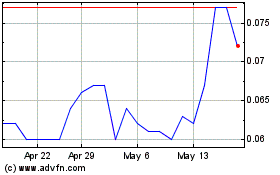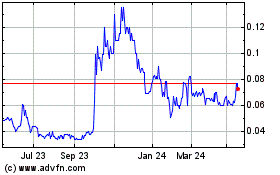Further Data Review Shows Major Clinical Benefits From Veyonda®
September 30 2019 - 8:00AM

Noxopharm (ASX:NOX) further describes the upcoming release of
clinical data concerning its lead drug candidate, Veyonda®. On
further review of the interim data, Noxopharm now sees an important
and exciting story emerging that it considers needs to be brought
to market attention.
Noxopharm is developing Veyonda® as a drug to
boost the effectiveness of two forms of radiation therapy in
prostate cancer with the aim of relieving pain, decreasing the
activity of the cancer and extending life. In one form, the
radiation is delivered externally (DARRT study). In the other, the
radiation is injected intravenously (LuPIN study). Today’s
announcement concerns the LuPIN study.
A review of recent clinical data presents compelling
evidence that Veyonda® boosts the anti-cancer effect of the
intravenous radiopharmaceutical,
177lutetium-PSMA-617 (or
177Lu-PSMA), in men with late-stage prostate cancer.
177Lu-PSMA is an experimental radioactive drug that was the
subject of a US$6 billion series of acquisitions by Novartis in
2018 and currently is in a Phase 3 registration study expected to
finish in 2020.
A major aim of the LuPIN study is to see if Veyonda® can boost
the effectiveness of 177Lu-PSMA radiation therapy so that more men
are able to complete their full course of radiation treatment
before their cancer progresses and they need to stop treatment.
Graham Kelly, Noxopharm Executive Chairman,
said, “This is exciting data because anti-cancer drug trials rarely
deliver such significant improvements in response rates. Veyonda®
has more than tripled the number of men able to stay on this kind
of radiation treatment, and we would expect that to translate into
longer survival times, which is supported by the data showing
Veyonda® providing an overall quadrupling of the time until the
cancer resumed growing.”
The data comes from two separate clinical
studies involving the same hospital and the same clinicians, as
well as similar patient selection criteria and treatment protocols.
Hence the validity in comparing the two sets of data.
In the first study, 14 patients were treated
with 177Lu-PSMA alone. In the second study, patients were treated
with 177Lu-PSMA in combination with Veyonda®.
| |
177Lu-PSMA |
177Lu-PSMA + Veyonda® |
|
| |
|
|
|
| Number of patients |
14 |
16 |
|
| Median starting PSA (ng/ml) |
88 |
147 |
|
| PSA response |
36% |
69% |
|
| Progression-free survival (months) |
2.0 |
8.4 |
|
| Able to start the 4th cycle |
21% |
69% |
|
The group receiving the combination therapy
started with a higher overall PSA (Prostate-Specific Antigen)
level, suggesting that the cancer was more progressed in this group
at the start of treatment.
The three endpoints used to measure anti-cancer effect all
showed a benefit from combining Veyonda® with 177Lu-PSMA
therapy.
- PSA response refers to a fall in PSA levels in blood of greater
than 50%. This is accepted by oncologists as a surrogate marker of
disease activity. Adding Veyonda®
to 177Lu-PSMA therapy
almost doubled the PSA response (69% with Veyonda®
vs 36% with 177Lu-PSMA alone).
- Progression-free survival (PFS). PFS is a measure of the time
from the start of treatment until the disease progresses.
PFS quadrupled through the addition of Veyonda®
(8.4 months vs 2.0 months with
177Lu-PSMA alone).
- Treatment duration. The addition of
Veyonda® meant that the number of men able to start
the 4th treatment cycle tripled to 69% from 21% with
177Lu-PSMA alone.
The combination therapy also was well tolerated, pointing to
Veyonda® as being safe to use in combination with radiation
therapy.
In summary, combination therapy of Veyonda® and 177Lu-PSMA
therapy shows benefits to patients well above that with 177Lu-PSMA
therapy alone and underscores the Company’s confidence in Veyonda®
eventually becoming a standard drug in the management of prostate
cancer.
About Veyonda®Veyonda® (previously known as
NOX66) is a suppository dosage formulation of the experimental
anti-cancer drug, idronoxil, that leads in the body to the
formation of a proprietary pro-drug form. Idronoxil specifically
inhibits the ability of cancer cells to respond to stress, such as
that induced by radiation, leading to loss of pro-survival
signaling via sphingosine-1-phosphate. Idronoxil also promotes the
STING mechanism, thereby activating the body’s immune system.
About LuPIN LuPIN is an Investigator-Initiated
Phase Ib/IIa, single-arm, open label study being conducted by
clinicians at St Vincent’s Hospital Sydney. The study is enrolling
56 men with metastatic castrate-resistant prostate cancer that is
progressing despite docetaxel, cabazitaxel and either abiraterone
and/or enzalutamide. The study is divided into 4 cohorts of 400 mg
(8 patients), 800 mg (8 patients), 800 mg (16 patients) and 1200 mg
(24 patients) Veyonda®. The Phase Ib arm of the study is intended
to establish the safety of the combination treatment. The Phase IIa
expansion arm is intended to establish the dose-response effect of
increasing Veyonda® levels on combination treatment safety and
efficacy. Imaging inclusion criteria include a PSMA PET/CT with
uptake intensity in metastases more than twice the normal liver
uptake and no discordant disease on FDG PET/CT. All men receive up
to 6 doses of 177Lu-PSMA 617 at 6- weekly intervals; the first 8
men received 400mg Veyonda® days 1-10. Following safety data review
of the first cohort (400 mg Veyonda®), the dose for patients 9-16
was escalated to 800mg Veyonda® for 10 days. The study then was
expanded to recruit a third cohort of 16 patients to receive 800 mg
Veyonda®. With further evidence of efficacy and good tolerability,
the study was expanded to include a fourth patient cohort (1200 mg
Veyonda®).
About NoxopharmNoxopharm is a clinical-stage
Australian drug development company with offices in Sydney and New
York. The Company has a primary focus on the development of
Veyonda® and is the major shareholder in Nyrada Inc, a spin-off
company developing a pipeline of non-oncology drugs.
www.noxopharm.com
|
Investor & Corporate Enquiries: |
Company Secretary: |
| Noxopharm Ltd |
David Franks |
| T: +61 2 9144 2223 |
T: +61 2 9299 9690 |
| E: info@noxopharm.com |
E: David.Franks@automicgroup.com.au |
| |
|
| Media Contact USA: |
Media Contact Australia: |
| Frank de Maria |
Prue Kelly |
| Purposeful Communications |
T : 0459 022 445 |
| T: +1 347 647 0284 |
E: Prue.Kelly@noxopharm.com |
| E: frank.demaria@purposefulcommunications.com |
|
Forward Looking StatementsThis
announcement may contain forward-looking statements. You can
identify these statements by the fact they use words such as “aim”,
“anticipate”, “assume”, “believe”, “continue”, “could”, “estimate”,
“expect”, “intend”, “may”, “plan”, “predict”, “project”, “plan”,
“should”, “target”, “will” or “would” or the negative of such terms
or other similar expressions. Forward-looking statements are based
on estimates, projections and assumptions made by Noxopharm about
circumstances and events that have not yet taken place. Although
Noxopharm believes the forward-looking statements to be reasonable,
they are not certain. Forward-looking statements involve known and
unknown risks, uncertainties and other factors that are in some
cases beyond the Company’s control that could cause the actual
results, performance or achievements to differ materially from
those expressed or implied by the forward-looking statement. No
representation, warranty or assurance (express or implied) is given
or made by Noxopharm that the forward-looking statements contained
in this announcement are accurate and undue reliance should not be
placed upon such statements.
Noxopharm (ASX:NOX)
Historical Stock Chart
From Dec 2024 to Jan 2025

Noxopharm (ASX:NOX)
Historical Stock Chart
From Jan 2024 to Jan 2025
